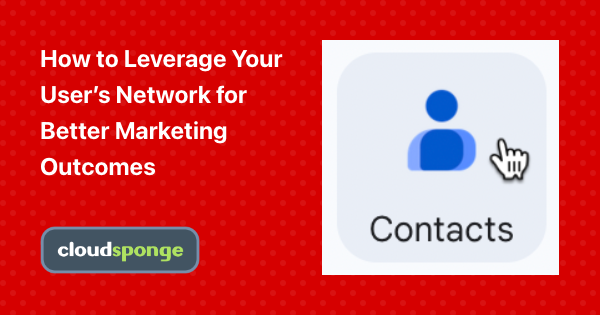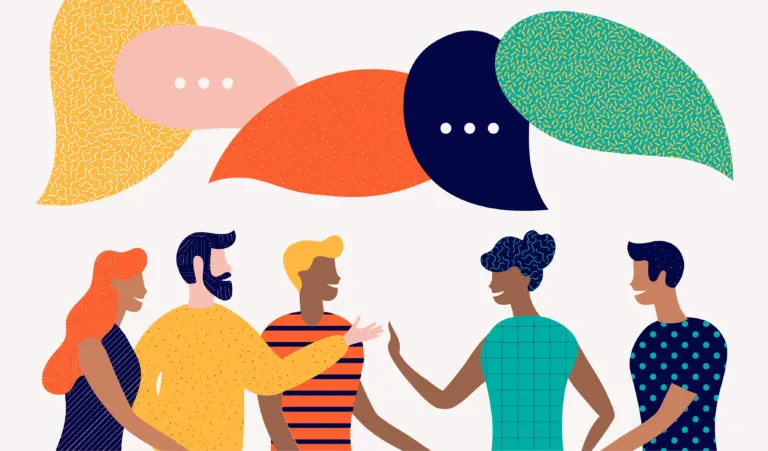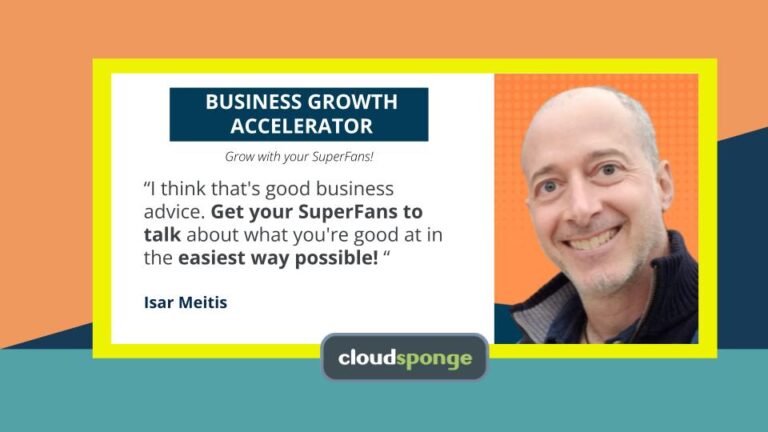If your job is to help grow a crowdfunding site, then I’m sure you’d love project creators to gain as much exposure for their projects as possible, right?
After all, every time they share their crowdfunding projects with people in their network, for example, their chances of reaching the funding goal grow exponentially.
But here’s the catch:
The responsibility for this happening lies entirely with you.
Why Does Sharing Crowdfunding Projects Boost Your Growth?
It’s simple. The more projects that are shared, the more people will be exposed to your crowdfunding platform. And this leads to increased visibility and interest in what you do. As such, your growth potential also increases significantly.
Plus, when project creators share their projects with their friends and family, it builds trust. This trust is incredibly important for any type of crowdfunding site because it encourages people to donate or invest without hesitation.
Just think about it – Your users don’t know how to optimize projects for the broadest reach. Nor they’re aware of the best ways to convince friends or family to help them out, be it by donating or spreading the word on the project further.
That’s why they’ve come to you, and they expect you to help. That’s also why it’s so important for you to provide features that allow users to share their crowdfunding projects with their networks in the most effective and efficient way.
That’s why they’ve come to you. And they expect you to help.
Luckily for you, in this post, I’ll show you exactly how to do it. You’ll learn five different strategies to implement to help users utilize personal connections.
Let’s dig in.
2013 paper, “Why crowdfunding projects can succeed,”
Why You Have to Help Users Involve Friends and Family First
4 years ago, three Italian researchers Giancarlo Giudici, Massimiliano Guerini and Cristina Rossi-Lamastra decided to analyze how two specific factors affect the potential for crowdfunding success:
- A person’s “individual social capital” – a term that simply describes their network of friends and family
- Their “territorial social capital” – people who reside close to the project’s creator.
And the result? As it turns out (note, the emphasis in bold is mine):
”[…] individual social capital has a significant positive effect on the probability to reach the target fund, while geolocalized capital has no significant effect. Interestingly, we find support to the hypothesis that territorial social capital may be even detrimental for crowdfunding, since it marginally weakens the signaling effect of the individual social capital.”
In short, it’s the personal network of friends and family that provides the foundation for a project to succeed.
But why?
Another research paper published by the National Bureau of Economic Research provides some explanation for this phenomenon:
“Friends and family disproportionately invest early in the funding cycle, generating a signal for later funders through accumulated capital. The asymmetry between friends and family and others in terms of funding behavior is strongest for the first investment decision but subsequently fades as funders are able to monitor the creator’s progress directly on the crowdfunding platform.”
Help Users Involve Friends and Family First with Crowdfunding Projects
That’s an awful lot of stuff to digest, so let’s break it down a little more: You need to help users involve their friends and family first if you want them to have any chance of succeeding with crowdfunding.
If they don’t have that strong start, they’re unlikely to make a dent in the broader market.
And this is where your assistance comes into play: You need to provide tools that make it easy for project creators to share their projects with their inner circle immediately.
This could be an automated email campaign or a simple one-click “Share on social media” button – whatever works best for you (more on how to best provide the tools and information later).
By supporting the project early, friends and family help send a strong credibility signal reassuring many other potential funders about the project.
And there are three primary reasons for this:
- Projects that acquired at least some funding seem more important to potential backers.
- Early funders often also spread information about the project, magnifying its reach.
- First backers provide useful feedback that helps project creators improve their content and presentation, increasing chances for more funding.
And all this simply means that the easier you make it for users to convince their immediate network to participate and fund projects, the greater their chance for reaching the funding goal will be.
Interestingly enough, we hear similar stories from crowdfunding sites using CloudSponge.
For example, not long ago, Tea Ho, Product Designer at DonorsChoose.org told us:
“We’ve found that when we encourage users to share their projects with their friends and family that it really unlocks opportunity and funding that hadn’t been there before, because getting even one donation on a project can build that project’s momentum and inspire strangers to support it.”
(You can read the entire DonorsChoose.org story here.)
So, let’s take a look at some ways you could help your users achieve similar results.
Utilize Your Network with These 5 Ideas for Project Creators
There are several ways to make your network work for you when it comes to crowdfunding. I’ve listed the top five possibilities to help project creators spread the word about their projects.
#1. Create thorough guides explaining how to share projects properly.
I guess a myth persists that to fund a project you just need to put it up on a crowdfunding site.
The reality, as you know very well, is entirely different.
With so many projects created each month, creators must understand how to optimize their idea for the broadest reach.
Heck, or even just to stand out from any other projects their network might discover on their own.
Help your users achieve this by creating thorough guides explaining how to set their projects up for success and communicate the value of helping out to their network.
Kickstarter, for example, offers their users 21 tips for sharing their projects.
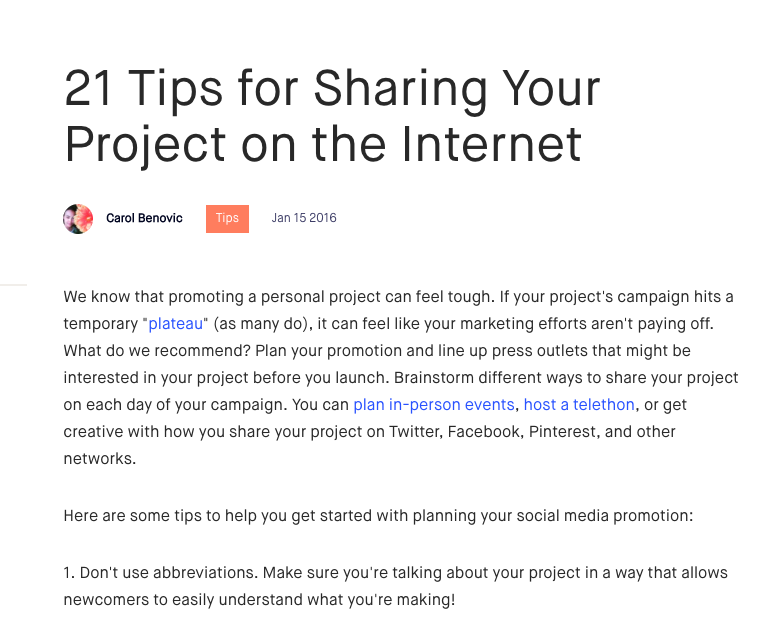
Their resource includes advice on anything from reminders about the most basic elements project creators tend to forget about, to tips for making use of referrer data to spot additional opportunities.
But I admit the Kickstarter’s guide is nothing but a collection of tips.
You, however, could go much further and create dedicated guides to various aspects of sharing a crowdfunding campaign.
#2. Provide ready-made copy that would help them inform their connections about the project.
Fact: How we ask for something determines the outcome we get.
Be it asking for help or money; our success largely depends on the arguments we make to convince someone to participate.
(And I’m sure you’ll agree, this need for solid argumentation makes the whole thing so much more difficult, doesn’t it?)
Now, I don’t think it’s too far-fetched to assume that your users don’t know how to convince their friends to help with the project.
As a result, many would resort to simply sending someone a link to the project, hoping they’ll figure out what a person wants them to do.
And only a few ask for help directly.
Luckily, you can help here too. Provide a ready-made copy, optimized for the highest possible success they could use or modify, if needs be.
Let’s take email, for example. When allowing users to share their project, you can either leave the email copy window empty or, like Kickstarter, add only the project’s name and link to the message:
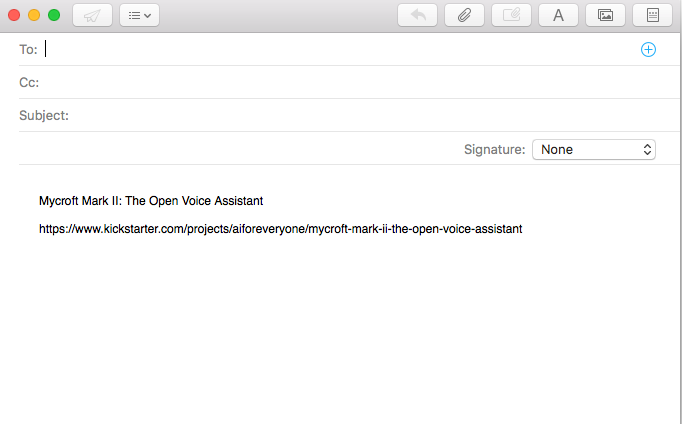
(The actual project share email from Kickstarter)
But I’m sure you’ll agree that actually pre-populating it with a short copy that would help creators inform someone about the project would work much better, no?
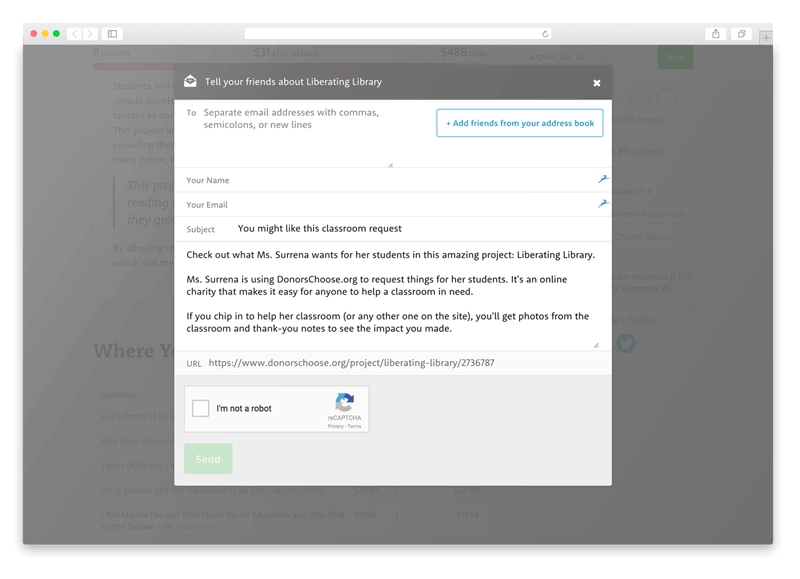
Notice how the above copy quickly introduces the project, explains why they receive the email and even promises a reward for participation – pictures and thank you notes for the support.
#3. Help project owners communicate their credibility
According to a paper called, “Some Simple Economics of Crowdfunding,” project creators face three major disincentives (disclaimer: discovered via ConversionXL):
- Creator incompetence,
- Fraud, and
- Project risk.
And it’s the first one that interests us the most. As the authors of the study point, “project creators typically have little experience in building a product and dealing with logistics and suppliers. Projects that exceed their funding goal by large amounts often deliver late (if at all), since they are unable to adjust to demand.”
They further point:
“In a study of the design and technology categories on Kickstarter, out of 247 successful projects that promised to deliver goods, more than 50% were delayed, and the average delay was more than two months.”
Now, I admit that these findings pertain to product-based projects. Nonetheless, donations and other crowdfunded projects might face similar challenges due to a person’s potential lack of competence in completing their ideas.
To help them overcome that friction, allow users to create profile pages and automatically showcase their past crowdfunding successes on your platform.
For example:
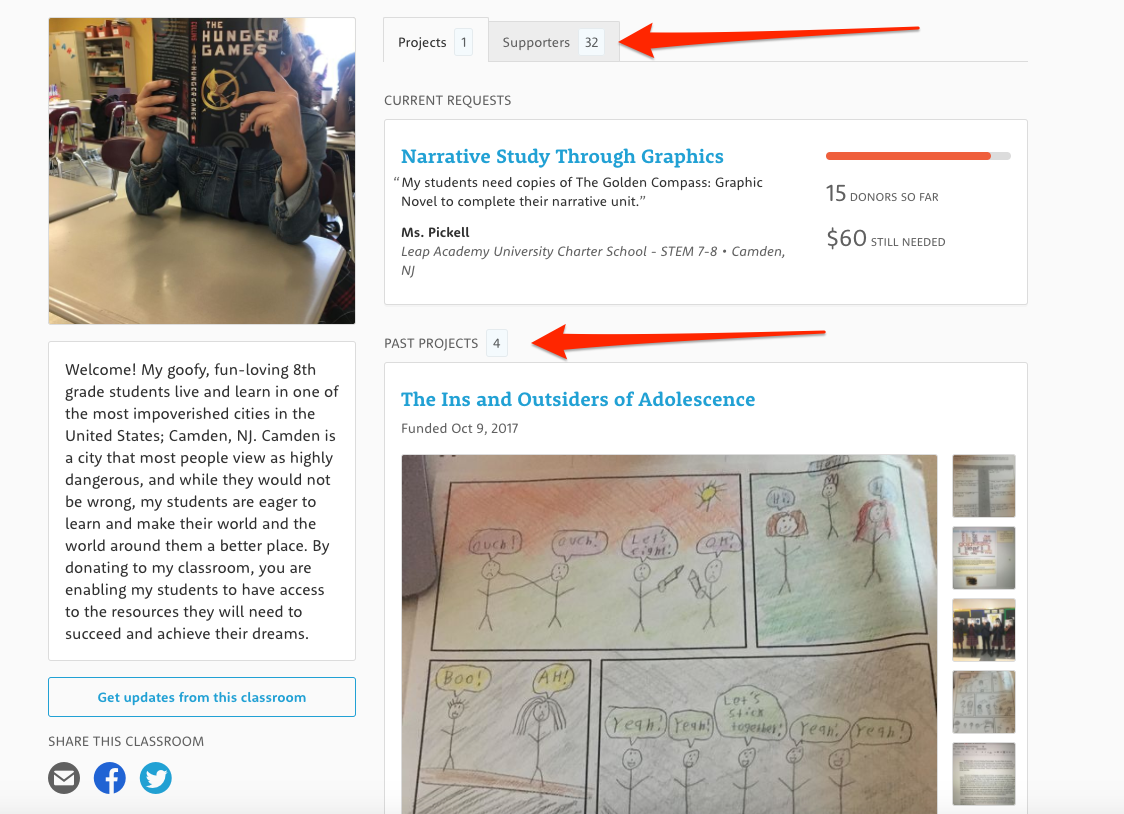
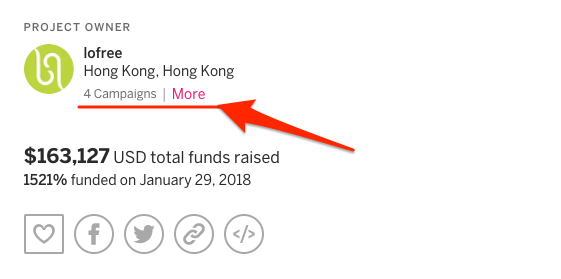
#4. Simplify the actual sharing process
Although there are many different channels your users could use to share their project, they all fall under one of those three categories:
- Social Media
- Webpage links
For example, DonorsChoose.org offers the ability to share projects on social media and via email.
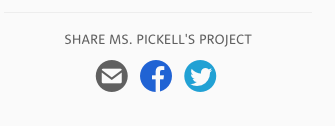
And simplifying the process even further by allowing users to upload their address books to the system effortlessly turned out to be one of the milestones for the company.
“Our three year average in a before/after comparison…resulted in a 65% increase in the number of emails sent.”
GoFundMe focuses only on social media, with a strong emphasis on Facebook:
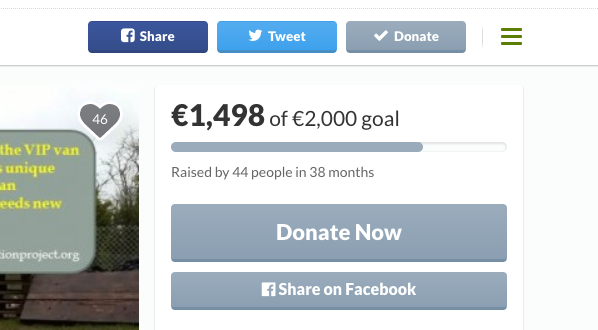
However, GoFundMe also implemented address book importing into their product. You can see it in action here:
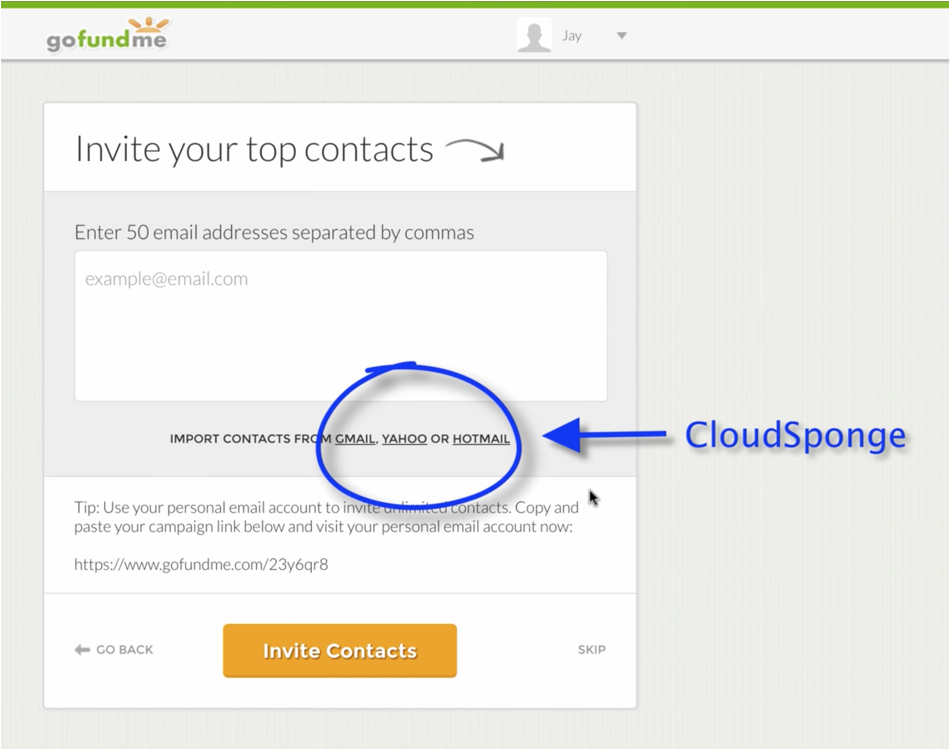
Indiegogo allows users to embed a project on your site. However, they don’t seem to have the email sharing option.
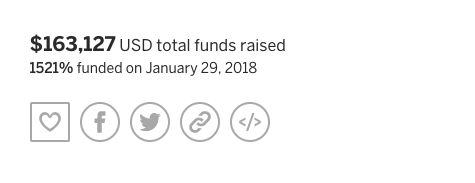
Leetchi on the other hand includes all sharing options – social media, email as well as a custom project link.

Regardless of which channels you choose, your goal is to make it as simple as possible for both project creators and their first backers to share it.
For the most part, this involves optimizing the user experience and the usability of your sharing options:
- Positioning sharing buttons where users can find them,
- Optimizing how they look like and making it obviously clear what those buttons are,
- Simplifying the sharing process,
- Optimizing messages for each channel to make it easy for creators and backers to share,
#5. Give project creators the option to set reminders
This goes without saying: Most of us are super busy.
And so, it’s easy to imagine that many other things might occupy your project creator’s friends’ attention.
As a result, they might not back the project right after receiving a notification about it. And even with the best intentions, simply forget to do it later.
One way to overcome this is by enabling reminders notifying project creators that someone they notified about a project hasn’t backed it up yet. They could, in turn, send them a project reminder or simply use the personal connection with the person to inquire about it.
Closing Thoughts
Your users stand a far greater chance of reaching their funding goal once they get friends and family to help.
But it’s your responsibility to help them do that.
And in this post, I showed you five different strategies you could implement to help users involve their personal network.

